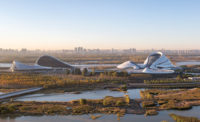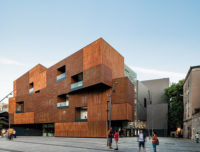CaixaForum
At a dynamic arts center, L-shaped volumes seem to float as they cantilever out to the surrounding city.

Perforated sheet-metal cladding gives the bulk a lighter feeling. At the back of the building, an outdoor emergency stair zigzags between dark polished-concrete supporting walls.
Photo © Rubén B. Pescós

The building is raised two stories to free the ground plane.
Photo © Rubén B. Pescós

The volume of the arts center hovers over the glazed lobby and projects over a smaller rooftop terrace.
Photo © Rubén B. Pescós

The main interior stair, triangular in plan, is punched up with red vinyl floors and balustrades of wood veneer.
Photo © Rubén B. Pescós

While the galleries are more neutral, their ceilings are enlivened with diagonal ventilation slots.
Photo © Rubén B. Pescós

The auditorium in the basement employs both free-form baffles and a rippling ceiling for acoustical modulation.
Photo © Rubén B. Pescós

Photo © Rubén B. Pescós

Image courtesy Estudio Carme Pinós

Image courtesy Estudio Carme Pinós

Image courtesy Estudio Carme Pinós

Image courtesy Estudio Carme Pinós

Image courtesy Estudio Carme Pinós

Image courtesy Estudio Carme Pinós













Architects & Firms
Zaragoza, Spain
"Everything I do is aimed at dynamizing my work,” Carme Pinós declares, “because dynamism communicates lightness.” Indeed, everywhere you turn in the CaixaForum, the arts center she has built in Zaragoza, Spain, something seems to be in motion. It can be the pairs of entwined columns in the lobby, angling away from each other like swirling dancers, or the massing of the building itself, where the two L-shaped volumes containing the galleries cantilever out in different directions from the circulation core.
Pinós employs these active forms to create a sense of vibrant urban place in a desolate area formerly occupied by a rail yard. The project, the winner of a 2009 competition, was part of a large urban redevelopment plan, but neither the neighboring commercial buildings nor the large park behind them materialized, due to Spain’s economic crisis. The latest in a number of CaixaForums, sponsored by La Caixa Bank and dedicated to traveling art exhibitions as well as social and educational programs, the Zaragoza venue is an example of how the private sector has taken a lead role in commissioning Spanish architecture as funding for public works disappears. Despite its bleak surroundings, the center is a success, the Barcelona-based architect states, attracting 400,000 visitors in its first year.
Pinós conceived the project as a portal between the historic city center and the working-class neighborhood literally on the other side of the tracks. The main volume is lifted a full two stories above the ground, “allowing the park to pass through the building and reach the city,” says Pinós. The ground-floor lobby under it is roofed by a publicly accessible terrace, a prefabricated concrete slab that floats in a daring cantilever over its glass walls.
The twin projecting volumes of the galleries, which also contain classrooms, offices, and a top-floor restaurant, are created from irregularly formed cubes overlapping in plan and shifted in section by one floor. Their outer faces are clad in gray metal panels, crisscrossed by patterns of perforations and backlit at night, giving the mass a sense of the lightness Pinós strives for. In contrast, L-shaped walls of dark polished concrete enclose the narrow side walls of the voids left by the intersection of the two volumes. The large trusses under the cantilevers are hidden behind the perforated cladding, but the ones at the roof, which respond to the tension loads of the overhangs, are exposed dramatically in the skylit ceilings of the top floor.
With its stacked organization, the building relies on elevators for circulation to the upper floors and escalators from the lobby to an underground auditorium. Additional escalators link the two galleries, located on different floors. Visitors can also use the public stair, whose triangular layout is boldly outlined by tube lighting that dances up the undersides of the balustrades.
“The idea was to make a more fluid connection between exhibitions,” Pinós explains. “The galleries are staggered in relation to each other, so when you leave one and approach the window in the escalator lobby, you see the city under the other. It gives you a moment of transition.” The galleries’ elongated shape, she points out, maximizes the linear feet of wall, for a more efficient use of the spaces when mounting exhibitions.
In its raised superstructure and vertical distribution, Pinós’s design is similar to the CaixaForum Madrid by Herzog & De Meuron (record, June 2008, page 108), where the Swiss architects lifted an old factory into the air to create a public plaza under it. In the Madrid CaixaForum, the public stair is more accessible, but the building lacks the ample views and natural light of Zaragoza, or luxuries such as its rooftop terrace, planted with olive trees.
There is a lot going on in Pinós’s design: you see lively patterns and surging forms at every turn, as in the fabric and acoustical wood paneling in the auditorium, or the curving, movable wood screens of the restaurant. Then there are those dancing columns in the lobby, which disappear into the irregular skylights of the aforementioned lower terrace cantilevered over the lobby. Splashed with natural light, the columns seem to hold up nothing at all (they discreetly intersect with the ends of beams in the skylight well). But Pinós handles these formal caprices with authority. With her first partner, the late Enric Miralles, with whom she collaborated until 1991, Pinós was a pioneer in this kind of free-form experimentation. In the aftermath of Spain’s economic debacle, such exuberance has come to seem extravagant and wasteful. But the architect says that the cost of her design, at 15 million euros ($16.5 million), is actually quite reasonable. She notes that modest finishes, such as floors of vinyl, industrial parquet, and concrete resin, help compensate for the expensive structural solution.
The CaixaForum is Carme Pinós’s most accomplished and important work in Spain to date. As she states in her project brief, “We want our building to be a symbol of technical progress and the generosity of culture—it should reflect only the best our age has to offer.” In this high aim, she has certainly succeeded, maintaining a steady course through the adverse circumstances of the moment.
PeopleArchitect: Estudio Carme Pinós — Carme Pinós Desplat, principal in charge and lead designer; Samuel Arriola, project manager; Elsa Martí, team Engineers: Boma Inpasa SL (structural); INDUS Ingeniería y Arquitectura (building services, cost consultant, quality surveyor) Construction Company: UTE Forum Zaragoza Client: Fundación “La Caixa” Size: 91,350 square feet Cost: $16.5 million Completion Date: March 2014 |
ProductsAluminum Panels for Facade: Arasaf Industrial Glass: Vidrio Doors: Gismero Steps and Prefab Slabs: Terrazos y Derivados Huesca Elevators: Kone |















